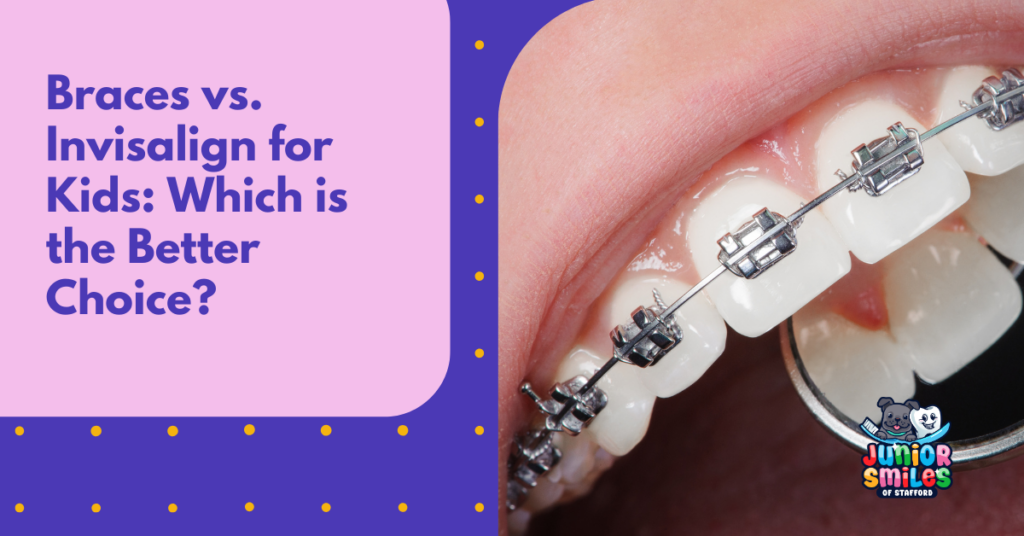Braces vs. Invisalign for Kids: Which is the Better Choice?

A straight, confident smile is something every parent wants for their child. Whether it’s for health reasons, aesthetics, or boosting self-esteem, orthodontic treatment can play a vital role in a child’s development. But with modern advancements in dentistry, parents now face a tough choice: Should I get braces or Invisalign for my child?
Both traditional braces and Invisalign offer effective solutions for straightening teeth, but they differ in various aspects such as appearance, cost, maintenance, and suitability. In this article, we’ll explore the key differences between braces and Invisalign for kids, the pros and cons of each, and how to decide which is the better choice for your child.
Understanding the Basics
What Are Braces?
Traditional metal braces consist of brackets that are bonded to the teeth and connected by wires and elastic bands. Over time, orthodontists adjust these wires to gradually move teeth into their desired positions.
Key Features:
- Made of stainless steel or ceramic
- Fixed appliances – cannot be removed
- Typically worn for 18–36 months
- Effective for even the most complex dental issues
What Is Invisalign?
Invisalign is a brand of clear aligners made from a flexible, BPA-free plastic material. They are custom-made using 3D imaging technology to gently and gradually move teeth.
Key Features:
- Removable and virtually invisible
- Replaced every 1–2 weeks with new sets
- Worn for 20–22 hours per day
- Suitable for mild to moderate alignment issues
Comparing Braces and Invisalign for Kids
| Feature | Braces | Invisalign |
| Appearance | Visible metal or ceramic brackets | Clear and almost invisible |
| Removability | Fixed in place | Removable by the user |
| Comfort | May cause irritation on gums/lips | Smooth, comfortable plastic |
| Dietary Restrictions | Yes (no sticky/hard foods) | No restrictions (can remove aligners) |
| Hygiene | Harder to clean; needs special care | Easier to brush and floss |
| Treatment Scope | Handles complex cases | Best for mild to moderate corrections |
| Compliance Needed | Less dependent on user | Requires responsibility and discipline |
| Checkups | Every 4–6 weeks | Every 6–8 weeks with new aligners provided |
| Cost | Generally more affordable | Slightly more expensive |
| Average Treatment Time | 18–36 months | 12–24 months (case-dependent) |
Pros and Cons of Braces for Kids
✅ Pros:
- Effective for Complex Cases
Braces can correct severe crowding, large gaps, bite misalignments (overbite, underbite, crossbite), and rotated teeth. - No Compliance Required
Since braces are fixed, kids can’t remove or forget them — making them ideal for younger or less disciplined children. - Multiple Options
Besides metal braces, there are ceramic (tooth-colored) and lingual braces (placed behind the teeth), offering some aesthetic variety. - Predictable Outcomes
Braces give orthodontists full control over the movement of each tooth, making treatment highly precise.
❌ Cons:
- Visible and May Affect Confidence
Some kids feel self-conscious about having metal on their teeth, especially during their middle or high school years. - Discomfort and Sores
Brackets and wires can irritate the inside of the mouth, especially after adjustments. - Food Restrictions
Kids must avoid hard, sticky, or chewy foods that could damage the brackets. - Challenging Oral Hygiene
Cleaning around brackets and wires requires extra time and tools like interdental brushes or water flossers.
Pros and Cons of Invisalign for Kids
✅ Pros:
- Aesthetic Appeal
Invisalign is practically invisible, making it a great choice for self-conscious kids. - Removable Convenience
Aligners can be taken out for meals, photos, and brushing/flossing. - Comfort
Smooth plastic design causes less irritation compared to metal brackets. - Fewer Emergency Visits
No wires breaking or brackets falling off means fewer unexpected trips to the orthodontist.
❌ Cons:
- Discipline Required
Kids need to wear aligners for 20–22 hours daily. Skipping this can delay treatment or compromise results. - Easily Lost or Damaged
Removable aligners can be forgotten, thrown away accidentally, or lost during activities. - Not Suitable for All Cases
Invisalign is ideal for mild to moderate misalignments but may not be effective for severe orthodontic problems. - Cost
Invisalign typically costs more than traditional braces, although prices vary by region and case complexity.
Invisalign First: Designed Specifically for Young Children
Invisalign has a product called Invisalign First, made specifically for kids aged 6–10. It’s designed for early interceptive orthodontics — correcting issues like narrow dental arches or crowding before all adult teeth come in.
Benefits of Invisalign First:
- Guides erupting teeth into proper positions
- Addresses spacing or arch development problems early
- Child-friendly design with minimal discomfort
Is Your Child a Good Candidate for Invisalign?
Not all children are ideal candidates for Invisalign. Here are some guidelines:
Ideal Invisalign Candidates:
- Have mild to moderate crowding or spacing issues
- Are responsible and can follow daily wear instructions
- Prefer a discreet option
- Participate in sports or activities where braces may be hazardous
Better Suited for Braces:
- Have complex bite or jaw alignment issues
- Tend to be forgetful or undisciplined
- Need faster or more predictable treatment for challenging cases
Your orthodontist will perform a full assessment, including x-rays and scans, to determine which treatment is better suited for your child’s dental condition and lifestyle.
Cost Comparison: Braces vs. Invisalign
Braces:
- Cost Range: $3,000–$7,000
- Insurance: Usually covered at least partially by dental insurance
- Follow-up Costs: May require extra visits for adjustments or repairs
Invisalign:
- Cost Range: $3,500–$8,000
- Insurance: Increasingly covered by insurance, but coverage may be limited
- Follow-up Costs: Replacement aligners or lost trays can incur additional charges
Ultimately, the cost will depend on the severity of the case, the length of treatment, and your geographic location. Many dental offices offer flexible payment plans.
Parental Concerns and Common Questions
1. Will Invisalign work as well as braces for my child?
For the right candidate, Invisalign can be just as effective. However, for complex dental issues, traditional braces still provide more comprehensive control.
2. What if my child loses an aligner?
Invisalign providers usually advise keeping the previous set of aligners and contacting them immediately for a replacement. Lost aligners can slow down progress, so parental supervision may be needed.
3. Are there any age limits for Invisalign?
Invisalign can be used as early as age 6 with Invisalign First. However, responsibility and maturity matter more than age when it comes to successful treatment.
4. How often do we need to visit the orthodontist?
- Braces: Every 4–6 weeks
- Invisalign: Every 6–8 weeks, often with fewer in-office adjustments
Real-Life Scenarios
Scenario 1: The Active Pre-Teen
Your 11-year-old plays soccer and is prone to falling or getting bumped.
Better Choice: Invisalign – no metal that could cut the inside of the mouth during sports.
Scenario 2: The Forgetful Tween
Your 10-year-old is constantly losing things — water bottles, jackets, lunch boxes.
Better Choice: Braces – they can’t be removed or lost, ensuring treatment stays on track.
Scenario 3: Mild Crowding and Appearance Concerns
Your 12-year-old has mild crowding and is shy about their appearance.
Better Choice: Invisalign – offers discreet treatment and fewer restrictions.
Scenario 4: Severe Overbite and Jaw Misalignment
Your 9-year-old has a significant overbite and needs early intervention.
Better Choice: Braces – more effective at correcting complex structural issues.
Final Verdict: Which is the Better Choice?
There is no one-size-fits-all answer. Both braces and Invisalign are excellent orthodontic tools — the best choice depends on your child’s:
- Age and dental development
- Personality and discipline
- Severity of the dental issue
- Lifestyle and activities
- Budget and insurance coverage
In general:
- Braces are ideal for complex cases and younger children.
- Invisalign is great for older, responsible kids with mild to moderate issues.
Conclusion
The decision between braces and Invisalign is an important one that will affect your child’s health, confidence, and comfort over several months or even years. By understanding the differences, pros, and cons of each option, and working closely with a trusted orthodontist, you can make an informed choice that supports your child’s needs and lifestyle.
Remember: It’s not just about straighter teeth — it’s about giving your child a healthy, confident smile for life.

